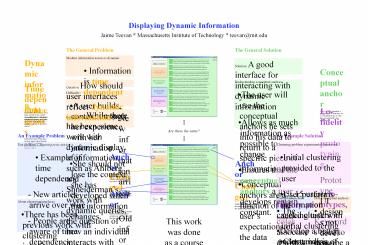Displaying Dynamic Information PowerPoint PPT Presentation
1 / 1
Title: Displaying Dynamic Information
1
Displaying Dynamic Information
Jaime Teevan Massachusetts Institute of
Technology teevan_at_mit.edu
The General Problem
The General Solution
- Modern information access is dynamic
- Information is time dependent
- New information arrives
- Old information expires
- Other agents than the user may modify the users
data
Dynamic information Information that changes,
over time, outside of our control. As our
interaction with shared information grows, so
will our interaction with dynamic information.
- Solution A good interface for interacting with
dynamic information - Allows as much information as possible to change
- Ensures that the conceptual anchors a user
develops remain constant.
Conceptual anchor Users can only remember a small
portion of what they see. A conceptual anchor is
what the user specifically does remember.
- Understanding conceptual anchors
- The user will use the conceptual anchors he sets
into his data to return to a specific piece of
information later - Conceptual anchors are a function of the users
expectations of the data - When watching the news on TV, you understand that
the information is time dependent, and remember
the time you saw the story - When reading the news in a newspaper, you may
instead remember the section where you saw the
story - A user has no expectation about the information
that has not been displayed to him - A user doesnt develop expectations about much of
the information that he has seen
Question How should user interfaces reflect
dynamic information?
Time dependent Some information is dynamic
because it becomes available over time. Examples
of this include stock prices and news stories.
- Difficulty
- A user builds context through her experience with
her information. - She should not lose the context she has developed
when that information changes.
Other agents Information may be dynamic because
agents other than the user (family, colleagues,
automated processes) also interact with it.
Lo-fidelity prototyping Prototype UI designs not
developed on a computer. Prototyping this way
allows for many design iterations.
Related work While there has been some work with
dynamic display of information, such as Ahlberg
and Shneidermans work with dynamic queries, the
question of how an individual interacts with
changes outside of his control is largely
unexplored. While the problem is new, it relates
to issues of UI consistency, discussed by Grudin
and others.
Are these the same?
An Example Solution
An Example Problem
- Clustering problem experimental framework
- Initial clustering provided to the user
- User performs information seeking task with
initial clustering - Clustering is modified
- - Document presentation ordering changes
- - Documents move to other clusters
- - Keywords representing the clusters are updated
- User asked to perform tasks that require a return
to information that she has seen before - Observe what changes the user notices, and what
changes make it easier/more difficult for the
user to complete the task
- Test problem Clustering news stories
- Example of time dependency
- - New articles arrive over wire
- - People are aware of time dependency issues
relating to of news stories - Example of other agents Clustering algorithm
also interacts with data - - A good clustering algorithm cannot produce
results immediately - - Clustering algorithm first produces a rough
initial clustering which is presented to the user
immediately - - As the user works with initial clustering,
algorithm works to improve clustering - - People are not used to the idea of another
agent manipulating their data. The fact that the
news articles are time dependent helps them
accept the fact that the articles may change
location due to multiple agents as well.
Anchor Users associate the color of the tab with
its content, and use the color, more than the
keywords, for navigation
Anchor Users tend to remember that the first
document in the list was first.
Changed The keywords describing the tab can
change as long as the general meaning doesnt.
Changed Small ordering changes with documents
that arent first or last in the list go
unnoticed.
Anchor Documents shouldnt change clusters
without the users permission. Arrows request
that the document be moved.
User testing 15 users, lo-fidelity prototypes,
canned clusters
- Conceptual anchors
- The color associated with a cluster
- Documents listed in cluster summary
- Which document is first
- NOT Conceptual anchors
- Keywords used to describe a cluster
- Ordering of documents within cluster
- Documents not seen in a cluster
- About clustering interfaces
- There has been previous work with clustering
interfaces (e.g. Scatter/Gather) - Previous clustering interfaces require the
clustering process to be entirely finished before
clusters can be displayed - By allowing partially completed clusters to be
presented that can later be updated, a better,
more time consuming, clustering algorithm can be
used - Note I use clusters as a convenient source of
dynamic information, and am not asking whether
clusters are helpful for information access
- Future work
- Develop a better understanding of what
information a person uses to build her conceptual
anchors - Investigate the problem in other domains (e.g.
Haystack)
This work was done as a course project for
Professor Stephen Intille.

